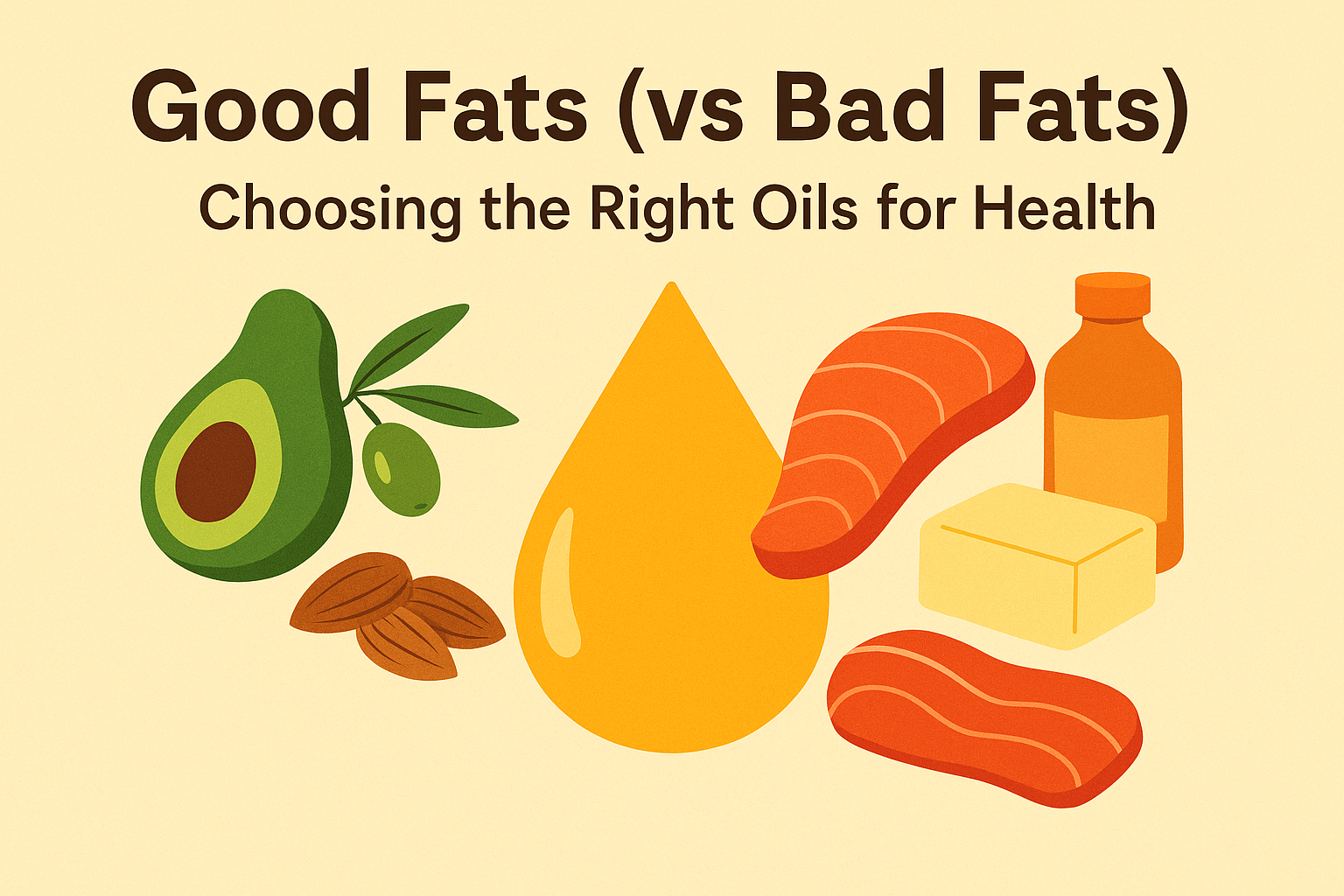
Good Fats vs Bad Fats — Choosing the Right Oils for Health
In the quest for healthier living, not all fats are equal. Some fats are harmful, while others are vital allies for our health. The key is recognizing the different types — and making better choices when cooking, eating, or shopping. In this article, we’ll break down the science, go into practical advice, and share the latest research to help readers make the right choice.
Why We Need Fats — A Quick Refresher
Fats (or lipids) are an essential macronutrient. Some of their roles include:
- Serving as a dense source of energy (9 calories per gram),
- Helping absorb fat-soluble vitamins (A, D, E, K),
- Supporting cell membrane integrity and nerve function,
- Acting as precursors for hormones and signaling molecules,
- Providing insulation and shock absorption in the body.
Thus, fat is not the enemy — but which fats, and how much, matter a lot.
All fats are made of triglycerides (a glycerol backbone and three fatty acid chains), but variation in chain length and degree of saturation leads to different types with very different health effects.
The Different Types of Fats
Broadly speaking, fats are classified into:
- Unsaturated fats
- Monounsaturated fats (MUFA)
- Polyunsaturated fats (PUFA)
- Omega-3 fatty acids
- Omega-6 fatty acids
- Saturated fats (SFA)
- Trans fats (especially industrial/partially hydrogenated fats)
Below is how they differ in structure and effect:
Fat Type | Chemical Feature | Physical Property (room temp) | Typical Food Sources | Typical Health Effect* |
Monounsaturated (MUFA) | One double bond | Liquid | Olive oil, avocado, almonds, canola oil | Often beneficial (e.g., improve lipid profile) |
Polyunsaturated (PUFA) | Two or more double bonds | Liquid | Fish oils (omega-3), flaxseed, walnuts, sunflower oil, soybean oil | Essential, various health benefits |
Saturated (SFA) | No double bonds | Usually solid | Butter, coconut oil, fatty meats, dairy | More neutral; best in cautious limits |
Trans fats (industrial) | “Trans” double bond orientation | Semi-solid to solid | Margarines, processed baked goods, fried foods | Unambiguously harmful in most contexts |
* “Typical health effect” is a generalization; actual impact is relative to amount, context, and what the fat is replacing in the diet.
Good Fats (The “Friendly” Ones)
Monounsaturated Fats (MUFA)
Monounsaturated fats are abundant in foods like olive oil, avocados, nuts (e.g., almonds, peanuts), and some seeds. The most widely known MUFA is oleic acid (the main fat found in olive oil).
Health benefits include:
- Improving cholesterol profile: Replacing saturated fat with MUFAs is associated with lower LDL (“bad”) cholesterol and sometimes higher HDL (“good”) cholesterol.
- Insulin sensitivity: Some studies suggest MUFAs may promote insulin sensitivity and help control blood sugar, which is important for reducing diabetes risk.
- Cardiovascular benefits: MUFA-rich diets (e.g., Mediterranean diet) have been linked with lower rates of cardiovascular disease.
Polyunsaturated Fats (PUFA)
Polyunsaturated fats include two essential types that the body cannot synthesize:
- Omega-3 fatty acids (e.g., EPA, DHA, ALA)
- Omega-6 fatty acids (e.g., linoleic acid)
These are found in fatty fish (salmon, mackerel, sardines), flaxseed, chia seed, walnuts, soybean oil, sunflower oil, and others.
Key benefits:
- Essential nutrients: Omega-3s are major factors for brain, heart, and eye health.
- Cholesterol lowering: PUFAs — especially when replacing saturated fats — can help reduce LDL cholesterol.
- Anti-inflammation: Omega-3s have been studied for their anti-inflammatory effects in cardiovascular, metabolic, and neurological health.
Importantly, it’s not just about eating more PUFAs, but also balancing omega-3 and omega-6 intake. Too much omega-6 relative to omega-3 may tilt toward pro-inflammatory processes, though modern evidence shows a more nuanced view.
Saturated Fats: Friend, Foe, or “It Depends”?
Saturated fats have long been considered “less healthy,” but recent research has added complexity.
What we know:
- Saturated fats are found in animal fats (meat, butter, dairy products), tropical oils (coconut oil, palm oil), and some processed foods.
- When consumed in excess, saturated fat can raise LDL cholesterol, a risk factor for cardiovascular disease.
- Not all saturated fats or food sources behave the same way. For example, saturated fat in dairy may have different effects than fat in processed meats.
- Some recent meta-analyses suggest that saturated fat itself does not necessarily increase heart disease risk if replaced by unsaturated fat rather than refined carbohydrates.
- Replacing saturated fat with high-quality carbs or unsaturated fats (especially PUFAs) is more beneficial than simply reducing saturated fat intake.
Thus, saturated fat is better viewed more neutrally: okay in moderation, depending on the overall diet pattern and what replaces it.
Trans Fats (Industrial) — The One Fat to Avoid
Trans fats — especially industrially produced partially hydrogenated oils — are universally agreed to be harmful. They:
- Raise LDL (“bad”) cholesterol
- Lower HDL (“good”) cholesterol
- Promote inflammation and insulin resistance
- Increase risk of heart disease, stroke, and other chronic diseases
Because of strong evidence against them, many countries have banned or severely restricted industrial trans fats in the food supply. Even small amounts are thought harmful, so the best approach is to avoid processed foods that list “partially hydrogenated oils” in their ingredients.
Choose Oils Wisely — Simple Tips for a Healthier Lifestyle
- Use healthy and stable oils
- For low-to-medium heat or salad dressings, extra virgin olive oil is great.
- For higher heat, use high-oleic oils (high in monounsaturated fats).
- Coconut oil and palm oil can be used occasionally, but not for everyday cooking.
- Avoid reheating or reusing oils, as overheated oils degrade and form harmful compounds.
- Get fats from whole foods too
- Eat fatty fish like salmon or sardines once or twice a week.
- Snack on nuts, seeds, or avocados in moderation.
- Add ground flaxseed or chia seeds for plant-based omega-3s.
- Learn to read labels
- Products with “partially hydrogenated oils” contain trans fats.
- Prefer oils with a single ingredient (e.g., “olive oil”) over blends with additives.
- Don’t just add, replace
- Replace butter or margarine with olive oil or avocado spread.
- Swap saturated-fat-heavy snacks with nuts or seeds.
- Choose healthy fats instead of refined carb snacks (e.g., nut butter on whole-grain bread).
- Watch balance and portion size
- 20–35% of daily calories should come from fat (depending on energy needs).
- Saturated fats should stay below 10% of total calories, ideally replaced with unsaturated fats.
- Keep omega-3/omega-6 ratios balanced through good food choices or supplements if needed.
Scientific Evidence & Emerging Insights
The “diet-heart hypothesis” and re-evaluation of saturated fats
For decades, the “diet-heart hypothesis” posited that saturated fat raises cholesterol, which drives heart disease. Recent research questions whether this simple chain is universally true. Re-analyses and meta-analyses suggest the relationship is more complex, depending on dietary context and food sources.
Replacement matters
Replacing saturated fat with polyunsaturated fat (not refined carbs) consistently shows the greatest cardiovascular benefit.
Lipids aren’t the whole story
Fats also influence:
- Inflammation — trans fats and high amounts of saturated fats may provoke inflammatory pathways.
- Endothelial function — unsaturated fats support healthy blood vessel function.
- Insulin regulation — MUFAs and PUFAs may improve glucose control compared to saturated fats.
- Fat storage and metabolism — different fats are metabolized differently depending on activity levels.
A few recent findings
- Low-fat diets and hormones: Very low-fat diets may reduce testosterone levels in men, linking fat intake to hormonal health.
- Saturated fat effects: Very low saturated fat intakes may not provide extra benefit in already healthy diets.
- Seed oil criticism: Despite concerns about omega-6, evidence shows higher linoleic acid intake may lower cardiovascular risk.
- Food matrix effect: Whole foods like dairy or dark chocolate may produce different effects than the same fats in processed forms.
Summary & Take-Home Messages for Readers
- “Good” fats (unsaturated fats including MUFAs and PUFAs) are allies for heart, metabolic, and brain health.
- Saturated fats can be consumed in moderation, especially if replaced with unsaturated fats and sourced from whole foods.
- Trans fats (industrial) should be avoided completely.
- Context and replacement matter — what you substitute often determines the outcome more than absolute fat intake.
- Balance, variety, and moderation are key. Even healthy fats are calorie-dense.
- Practical solutions: use stable oils, choose whole food sources, limit processed fats, read ingredient lists, and make smart swaps.
